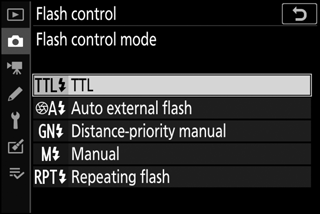Flash Control Mode
When a flash unit that supports unified flash control (an SB-5000, SB-500, SB-400, or SB-300) is mounted on the camera, the flash control mode, flash level, and other flash settings can be adjusted using the Flash control > Flash control mode item in the photo shooting menu (in the case of the SB-5000, these settings can also be adjusted using the controls on the flash unit). The options available vary with the flash used, while the options displayed under Flash control mode vary with the mode selected. Settings for other flash units can only be adjusted using flash unit controls.

- TTL: i-TTL mode. In the cases of the SB-500, SB-400, and SB-300, flash compensation can be adjusted using the Flash compensation item in the photo shooting menu.
- Auto external flash: In this mode, output is adjusted automatically according to the amount of light reflected by the subject; flash compensation is also available. Auto external flash supports “auto aperture” (qA) and “non-TTL auto” (A) modes. See the flash unit manual for details.
- Distance-priority manual: Choose the distance to the subject; flash output will be adjusted automatically. Flash compensation is also available.
- Manual: Choose the flash level manually.
- Repeating flash: The flash fires repeatedly while the shutter is open, producing a multiple-exposure effect. Choose the flash level (Output), the maximum number of times the unit fires (Times), and the number of times the flash fires per second (Frequency, measured in Hertz). The options available for Times vary depending on the options selected for Output and Frequency; see the documentation provided with the flash unit for details.
Unified Flash Control
Unified flash control allows the camera and flash unit to share settings. If a flash unit that supports unified flash control is mounted on the camera, changes to flash settings made with either the camera or flash unit are reflected on both devices, as are changes made using optional Camera Control Pro 2 software.
i-TTL Flash Control
When a CLS-compatible flash unit is set to TTL, the camera automatically selects one of the following types of flash control:
- i-TTL balanced fill-flash: The flash unit emits a series of nearly invisible preflashes (monitor preflashes) immediately before the main flash. The camera analyzes preflashes reflected from objects in all areas of the frame and adjusts flash output for a natural balance between the main subject and ambient background lighting.
- Standard i-TTL fill-flash: Flash output is adjusted to bring lighting in the frame to standard level; the brightness of the background is not taken into account. Recommended for shots in which the main subject is emphasized at the expense of background details, or when exposure compensation is used. Standard i-TTL fill-flash is activated automatically when spot metering is selected.
